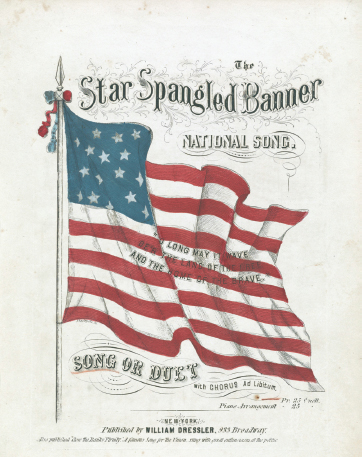CHARACTERISTICS OF TUNES
The best way to grasp the characteristics of tunes is by singing one you know, either out loud or in your head.
Division into Phrases Tunes fall naturally into smaller sections, called phrases. This is, in fact, true of all melodies, but with tunes the division into phrases is particularly clear and sharp.
In tunes with words (that is, songs), phrases tend to coincide with poetic lines. Most lines in a song lyric end with a rhyming word and a punctuation mark such as a comma. These features clarify the musical phrase divisions:
And the rockets’ red glare,
The bombs bursting in air
Singing a song requires breathing — and the natural tendency is to breathe at the end of phrases. You may not need to breathe after phrase 1 of our national anthem, but you’d better not wait any longer than phrase 2:


Balance between Phrases In many tunes, all the phrases are two, four, or eight bars long. Blues tunes, for example, usually consist of three four-
Most phrases of “The Star-
Other phrase lengths — three measures, five, and so on — can certainly occur in a tune and make for welcome contrast. For a good tune, the main requirement is that we sense a balance between the phrases, in terms of phrase lengths and in other terms, too, so that taken together the phrases add up to a well-
Parallelism and Contrast Balance between phrases can be strengthened by means of parallelism. For example, phrases can have the same notes but different words (“Oh, say can you see,” “Whose broad stripes and bright stars”). Others have the same rhythm but different pitches (“Oh, say can you see,” “By the dawn’s early light”).
Sometimes phrases have the same general melodic shape, but one phrase is slightly higher or lower than the other (“And the rockets’ red glare,” “The bombs bursting in air”). Such duplication of a phrase at two or more different pitch levels, called sequence, occurs frequently in music, and is a hallmark of certain musical styles.
Composers also take care to make some phrases contrast with their neighbors — one phrase short, another long, or one phrase low, another high (perhaps even too high, at “O’er the land of the free”). A tune with some parallel and some contrasting phrases will seem to have a satisfying coherence and yet will avoid monotony.
Climax and Cadence A good tune has form: a clear, purposeful beginning, a feeling of action in the middle, and a firm sense of winding down at the end.
Many tunes have a distinct high point, or climax, which their earlier portions seem to be heading toward. Feelings rise as voices soar; a melodic high point is always an emotional high point. The climax of our national anthem emphasizes what was felt to be the really crucial word in it — “free.” Patriot Francis Scott Key put that word in that place. (Key wrote the words of “The Star-
Then the later part of the tune relaxes from this climax, until it reaches a solid stopping place at the end. Emotionally, this is a point of relaxation and satisfaction. In a less definite way, the music also stops at earlier points in the tune — or, if it does not fully stop, at least seems to pause. The term for these interim stopping or pausing places is cadence.
Composers can write cadences with all possible shades of solidity and finality. “And the home of the brave” is a very final-